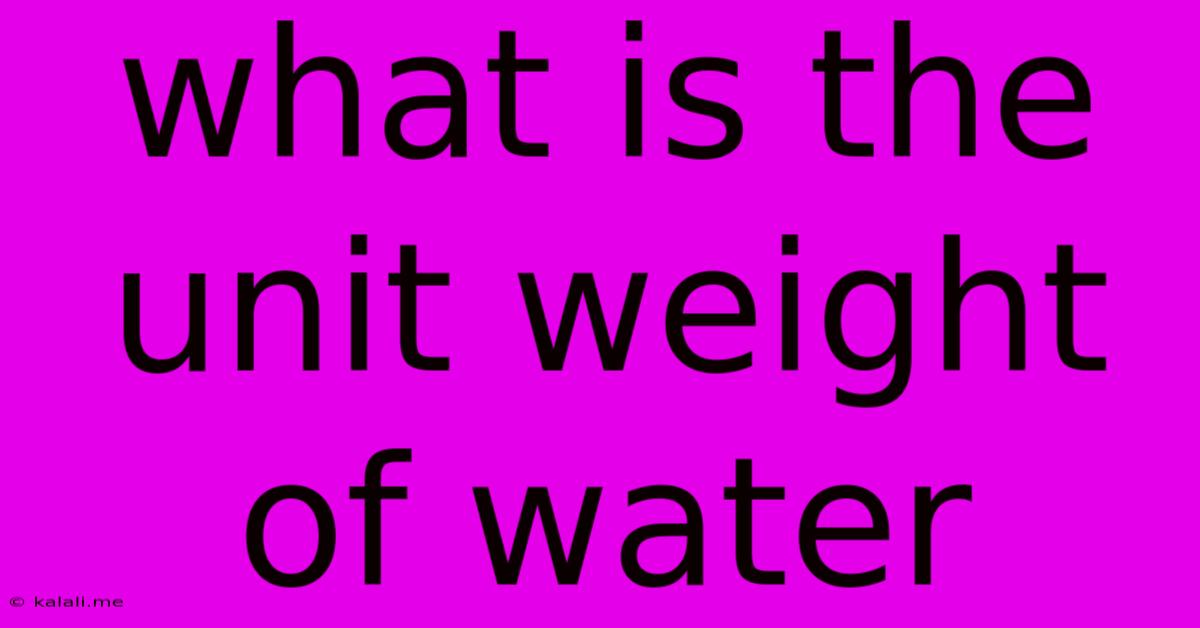What Is The Unit Weight Of Water
Kalali
Jun 14, 2025 · 3 min read

Table of Contents
What is the Unit Weight of Water? A Comprehensive Guide
The unit weight of water, a fundamental concept in many scientific and engineering disciplines, refers to the weight of a unit volume of water. Understanding this seemingly simple concept is crucial for accurate calculations in various fields, from hydrology and hydraulics to civil engineering and environmental science. This article will delve into the nuances of water's unit weight, its variations, and its practical applications.
What Factors Influence the Unit Weight of Water?
The unit weight of water isn't a constant; it varies primarily due to temperature and pressure. While pressure effects are typically negligible under normal conditions, temperature significantly impacts the density, and consequently, the unit weight. As water cools, its density increases until it reaches its maximum density at approximately 4° Celsius (39.2° Fahrenheit). Below this temperature, the density decreases slightly as ice forms.
Standard Unit Weight of Water:
Under standard conditions (typically defined as 4°C and 1 atmosphere of pressure), the unit weight of water is approximately 62.4 pounds per cubic foot (lb/ft³) or 9.81 kilonewtons per cubic meter (kN/m³). These values are frequently used as approximations in many calculations. However, it's crucial to remember that these are idealized values and can deviate slightly depending on the actual temperature and pressure.
Different Units and Conversions:
The unit weight of water can be expressed in various units depending on the context and the system of units used. Some common units include:
- lb/ft³ (pounds per cubic foot): Primarily used in the imperial system.
- kN/m³ (kilonewtons per cubic meter): Commonly used in the metric system.
- kg/m³ (kilograms per cubic meter): Represents the density of water in the metric system. To obtain the unit weight, multiply the density by the acceleration due to gravity (approximately 9.81 m/s²).
- g/cm³ (grams per cubic centimeter): Another metric unit for density, easily convertible to kg/m³.
Accurate conversions between these units are crucial for maintaining consistency in calculations. Online conversion tools are readily available for this purpose.
Practical Applications of Unit Weight of Water:
The unit weight of water plays a critical role in several applications:
- Hydrostatic Pressure Calculations: Determining the pressure exerted by water at a specific depth in a reservoir, pipe, or other water body.
- Dam Design and Stability Analysis: Essential for assessing the forces acting on dam structures and ensuring their stability.
- Irrigation and Drainage Engineering: Calculating water flow rates and designing irrigation and drainage systems.
- Flood Control and Management: Estimating flood volumes and designing flood control measures.
- Environmental Engineering: Analyzing water quality parameters and designing wastewater treatment systems.
- Civil Engineering: Foundation design, soil mechanics, and other geotechnical applications.
Conclusion:
While the standard unit weight of water provides a useful approximation, understanding the influence of temperature and pressure is critical for accurate calculations in various engineering and scientific disciplines. Using appropriate units and performing accurate conversions ensures the reliability of results, contributing to safe and efficient designs and analysis in countless applications. Always refer to relevant standards and specifications for the most accurate data based on specific conditions.
Latest Posts
Latest Posts
-
How To Find The Midpoint Of A Triangle
Jun 15, 2025
-
Which Of The Following Is An Example Of Punishment
Jun 15, 2025
-
Average Gpa For Iowa State University
Jun 15, 2025
-
Difference In Quantity Supplied And Supply
Jun 15, 2025
-
The Rate At Which Energy Is Transferred Is Called
Jun 15, 2025
Related Post
Thank you for visiting our website which covers about What Is The Unit Weight Of Water . We hope the information provided has been useful to you. Feel free to contact us if you have any questions or need further assistance. See you next time and don't miss to bookmark.